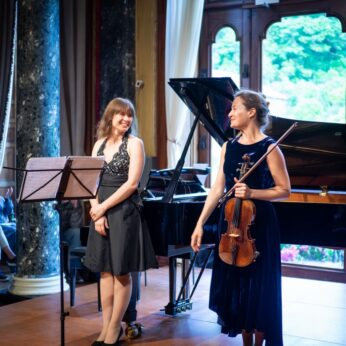Composer: Grigori Frid (b. 1915 - d. 2012)
Performance date: 02/07/2022
Venue: Bantry House
Composition Year: 1971
Duration: 00:15:48
Recording Engineer: Eduardo Prado, Ergodos
Instrumentation: va, pf
Instrumentation Category:Duo
Artists:
Dana Zemtsov -
[viola]
Anna Fedorova -
[piano]

Grigori Frid [1915-2012]
Viola Sonata No.1 Op.62 [1971]
1. Tranquillo e molto cantabile
2. Allegro
3. Lento
It is difficult to say. It just happened that I started to write for the viola. I think it is its timbre. I am
of the opinion that one should not write virtuoso works for the viola. I do not mean that one cannot
play virtuoso works on the viola, but I simply think that one should approach the viola in a different
way, compared to the violin. In a sense, the viola is inferior to the violin in technical possibilities in a
particular diapason. It is not without reason that the repertoire for the violin and the cello in its quantity
and range is more diverse. The viola’s timbre is the most important. The viola is ideal for quiet and slow
music. It is an instrument for reflection and contemplation.
Grigori Frid grew up in a time when it was dangerous to be either an intellectual or an artist; his father was twice imprisoned during the Stalinist purges. Frid was multi-talented composing three symphonies, two chamber operas to his own libretti and a large body of chamber music as well as being an exhibited visual artist and author of two volumes of recollections.
His First Viola Sonata was written for Feodor Druzhinin, also the dedicatee of Shostakovich’s Viola Sonata, to be heard later in this recital. He was also violist in the Beethoven Quartet, who premiered nearly all of Shostakovich’s quartets. The Tranquillo e molto cantabile opening movement begins with solo muted viola, whose strange and special timbre dominates this elegiac movement. Towards the end Frid adds rhythmic alterations to the theme, played in canon, using the highest register of the viola until everything vanishes. The aggressive second movement is a complete contrast featuring an old-fashioned battle between a percussive, toccata-like piano and a mournful viola theme fighting to be heard. As the aggression slowly fades the last movement gently takes over. This turns out to be the viola’s long cadenza supported by occasional chords from the now vanquished piano. The viola’s long monologue is delivered ad libitum rising to a sudden, desperate climax before a muted coda recalling the strangeness of the first movement. The melody climbs to the highest reaches of the viola before quietly vanishing unresolved.
Francis Humphrys
Copyright © 2024 West Cork Music. All rights reserved.
Designed and developed by Matrix Internet